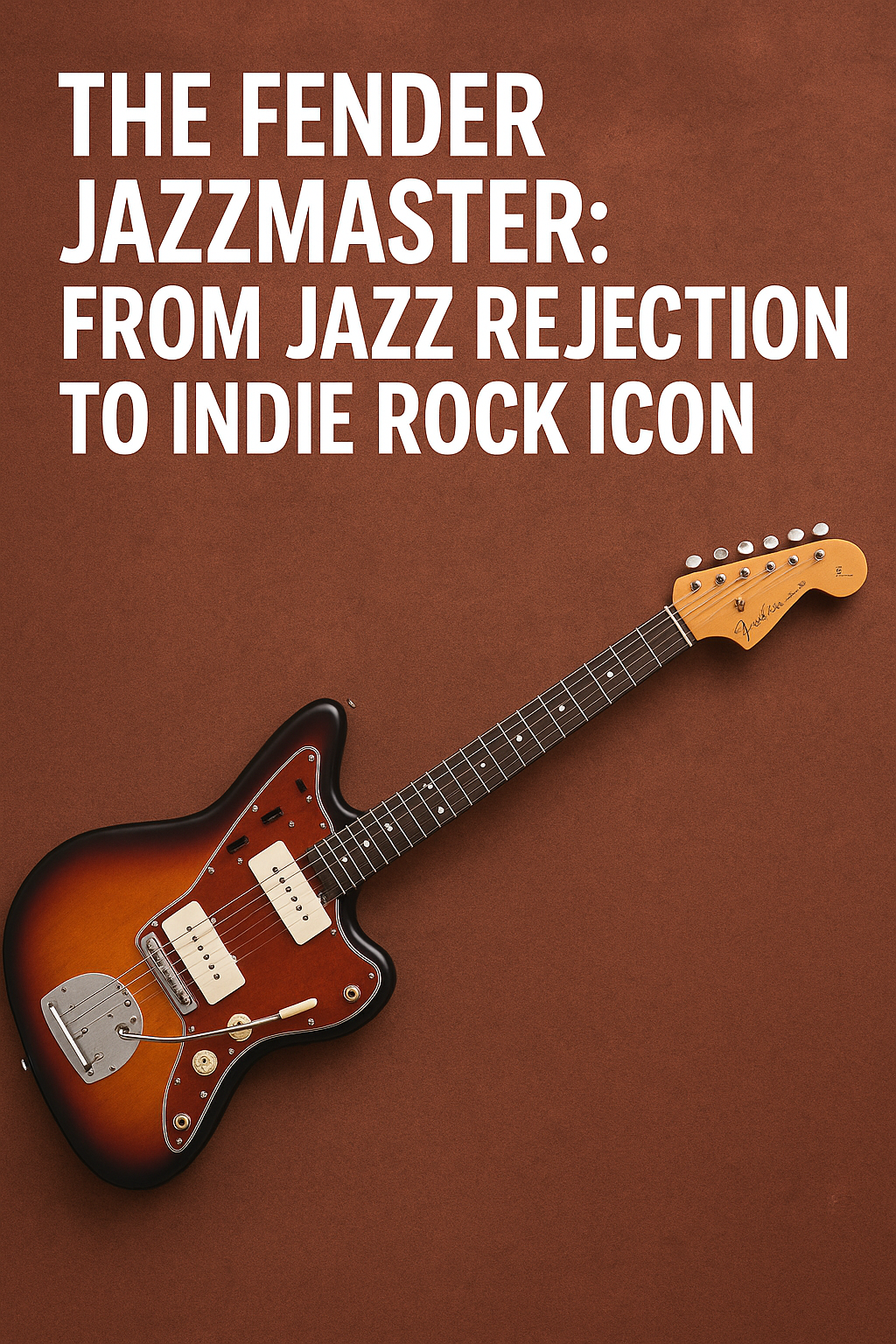Originally designed to seduce jazz guitarists, the Fender Jazzmaster didn’t quite land where Leo Fender intended. But what began as a commercial misfire in the late ’50s has evolved into one of the most beloved and distinctive guitars in modern music—especially in the hands of outsiders, innovators, and sonic rebels.
This is the story of the Fender Jazzmaster: how it went from jazz lounges to underground clubs, surf stages, and indie rock stardom.
A Jazz Guitar That Jazz Players Didn’t Want
Introduced in 1958, the Fender Jazzmaster was Leo Fender’s attempt to break into the highbrow jazz market. It had a more “sophisticated” offset body shape, a mellow tone circuit designed for smooth, dark jazz tones, and a floating tremolo system that allowed for subtle vibrato effects. It was also the first Fender guitar to feature a rosewood fretboard, a response to complaints that the maple boards on earlier Strats and Teles were too bright and clacky.
But jazz players largely stuck with their archtops and hollowbodies—and the Jazzmaster quickly found a different audience.
Specs and Features That Defined a Rebel
The Jazzmaster’s unusual design, while off-putting to some traditionalists, offered forward-thinking players a lot to work with:
-
Offset contoured body – More ergonomic for playing seated or standing
-
Dual-circuit electronics – Lead and rhythm circuits with independent tone/volume controls
-
Wide, flat single-coil pickups – Unique tone with less hum and a mellow top end
-
Floating tremolo and bridge – Capable of expressive pitch bends and shimmer
-
Longer 25.5” scale length – Fender’s standard, for snappy string tension
-
Distinctive “soapbar” pickup covers – Though similar in look to P-90s, they have a very different sound
Initially seen as Fender’s most high-end guitar, the Jazzmaster became a favorite of surf guitarists in the early ’60s, thanks to its lush tremolo and glassy tones. But it really came into its own decades later.
The Jazzmaster Renaissance: Punk, Shoegaze & Indie
By the late ’70s and ‘80s, Jazzmasters were cheap and plentiful on the used market—and that’s when things got interesting. Punk and alt-rock guitarists, uninterested in flashy Les Pauls or Strats, found a gritty elegance in the Jazzmaster’s quirky features and deep, atmospheric tones.
Key Artists and Famous Users:
-
Elvis Costello – One of the first post-punk artists to champion the Jazzmaster; his 1977 debut featured it prominently.
-
Tom Verlaine (Television) – Known for weaving glassy, interlocking parts on Marquee Moon.
-
J Mascis (Dinosaur Jr.) – Fuzzed-out, loud, and melodic; perhaps the most iconic Jazzmaster player of the alt-rock era.
-
Kevin Shields (My Bloody Valentine) – Used the Jazzmaster to create the woozy textures of Loveless.
-
Thurston Moore & Lee Ranaldo (Sonic Youth) – Took the Jazzmaster into noise and experimental realms, often heavily modded.
-
Nels Cline (Wilco) – Jazzmaster virtuoso with a jazz heart, ironically, making the guitar do what it was originally designed for.
-
Troy Van Leeuwen (Queens of the Stone Age) – A modern-day champion of offset guitars and swirling ambient tones.
Landmark Recordings Featuring the Jazzmaster
Here are just a few standout recordings where the Jazzmaster’s distinctive voice plays a central role:
-
My Bloody Valentine – Loveless
The Jazzmaster’s floating trem and unique pickup response were essential to Kevin Shields’ “glide guitar” technique.
-
Dinosaur Jr. – Where You Been
J Mascis layers thick, saturated Jazzmaster riffs into a wall of fuzz and melody.
-
Sonic Youth – Daydream Nation
Tuned-down, twisted, and experimental—Jazzmasters in alternate tunings are everywhere.
-
Wilco – Sky Blue Sky
Nels Cline uses his Jazzmaster to blend melodic phrasing with wild improvisational textures.
-
Elvis Costello – This Year’s Model
His early use helped reposition the Jazzmaster as a punk-adjacent workhorse.
From Cult Classic to Fender Staple
In the 2000s, Fender began to fully embrace the Jazzmaster’s new identity. It went from a quirky oddball to a full-on hero model, spawning:
-
Classic Player and Vintera models
-
Signature series for J Mascis, Troy Van Leeuwen, Jim Root, Johnny Marr (on the Jaguar, but close kin), and more
-
American Professional and American Vintage series
-
Squier Classic Vibe and J Mascis Squier Jazzmaster – now beloved in their own right
The Jazzmaster’s resurgence helped usher in an offset revival, and today, it’s one of Fender’s most popular guitar shapes across both vintage reissue and modern formats.
Conclusion: A Guitar for Outsiders and Originals
The Fender Jazzmaster might not have been embraced by the jazz crowd, but its journey is a classic case of gear finding its true purpose in the hands of creative misfits. With its unconventional design and unmistakable tone, it continues to inspire players across genres—from surf and shoegaze to indie rock and experimental jazz.
It’s not just a guitar—it’s a statement.









